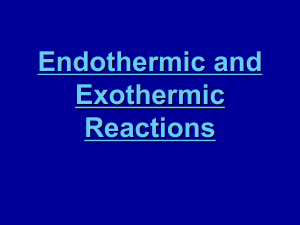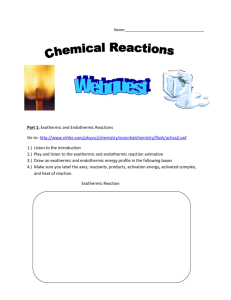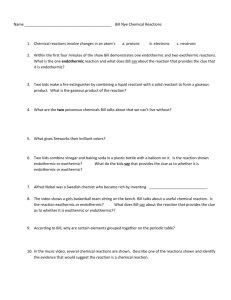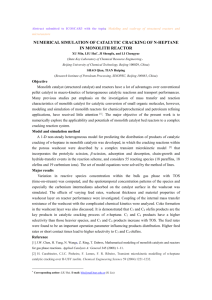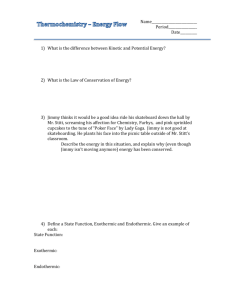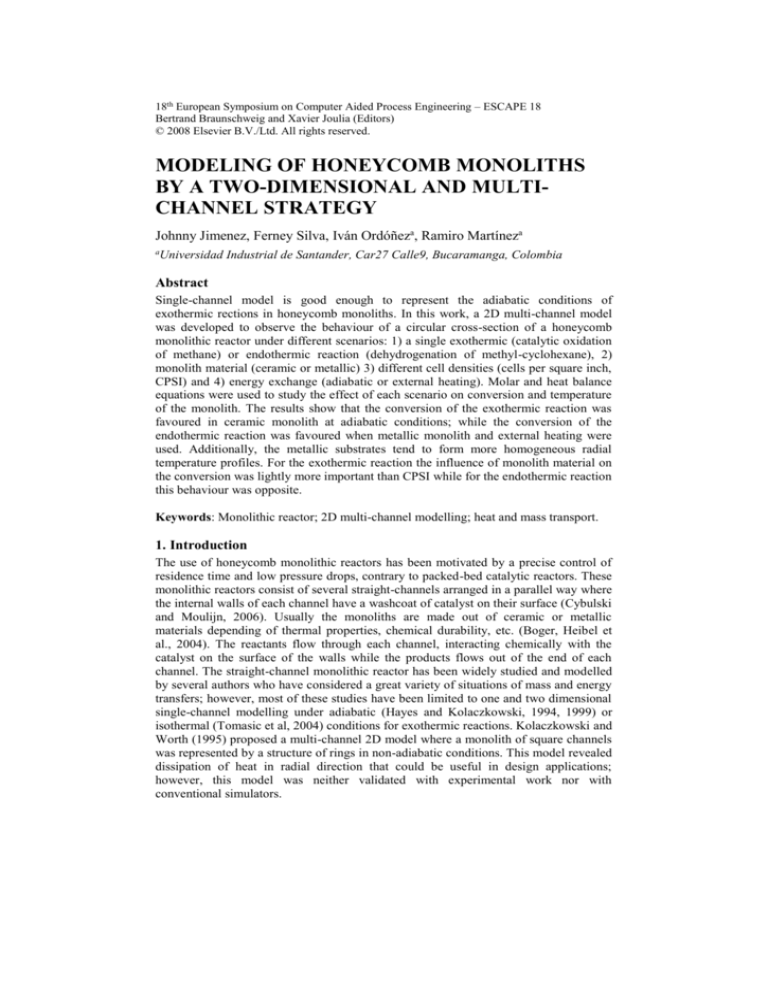
18th European Symposium on Computer Aided Process Engineering – ESCAPE 18
Bertrand Braunschweig and Xavier Joulia (Editors)
© 2008 Elsevier B.V./Ltd. All rights reserved.
MODELING OF HONEYCOMB MONOLITHS
BY A TWO-DIMENSIONAL AND MULTICHANNEL STRATEGY
Johnny Jimenez, Ferney Silva, Iván Ordóñeza, Ramiro Martíneza
a
Universidad Industrial de Santander, Car27 Calle9, Bucaramanga, Colombia
Abstract
Single-channel model is good enough to represent the adiabatic conditions of
exothermic rections in honeycomb monoliths. In this work, a 2D multi-channel model
was developed to observe the behaviour of a circular cross-section of a honeycomb
monolithic reactor under different scenarios: 1) a single exothermic (catalytic oxidation
of methane) or endothermic reaction (dehydrogenation of methyl-cyclohexane), 2)
monolith material (ceramic or metallic) 3) different cell densities (cells per square inch,
CPSI) and 4) energy exchange (adiabatic or external heating). Molar and heat balance
equations were used to study the effect of each scenario on conversion and temperature
of the monolith. The results show that the conversion of the exothermic reaction was
favoured in ceramic monolith at adiabatic conditions; while the conversion of the
endothermic reaction was favoured when metallic monolith and external heating were
used. Additionally, the metallic substrates tend to form more homogeneous radial
temperature profiles. For the exothermic reaction the influence of monolith material on
the conversion was lightly more important than CPSI while for the endothermic reaction
this behaviour was opposite.
Keywords: Monolithic reactor; 2D multi-channel modelling; heat and mass transport.
1. Introduction
The use of honeycomb monolithic reactors has been motivated by a precise control of
residence time and low pressure drops, contrary to packed-bed catalytic reactors. These
monolithic reactors consist of several straight-channels arranged in a parallel way where
the internal walls of each channel have a washcoat of catalyst on their surface (Cybulski
and Moulijn, 2006). Usually the monoliths are made out of ceramic or metallic
materials depending of thermal properties, chemical durability, etc. (Boger, Heibel et
al., 2004). The reactants flow through each channel, interacting chemically with the
catalyst on the surface of the walls while the products flows out of the end of each
channel. The straight-channel monolithic reactor has been widely studied and modelled
by several authors who have considered a great variety of situations of mass and energy
transfers; however, most of these studies have been limited to one and two dimensional
single-channel modelling under adiabatic (Hayes and Kolaczkowski, 1994, 1999) or
isothermal (Tomasic et al, 2004) conditions for exothermic reactions. Kolaczkowski and
Worth (1995) proposed a multi-channel 2D model where a monolith of square channels
was represented by a structure of rings in non-adiabatic conditions. This model revealed
dissipation of heat in radial direction that could be useful in design applications;
however, this model was neither validated with experimental work nor with
conventional simulators.
2
J. Jimenez et al.
In this work, the mass and energy transfers in a honeycomb monolithic reactor when
either an exothermic or an endothermic reaction takes place, are analyzed by using a 2D
multi-channel model that involves the following situations: insulation or external
heating, different types of material as well as different cell density (cells per square
inch, CPSI).
2. Multi-channel Modelling
2.1. Geometry of the 2D multi-channel model
We consider a straight monolith reactor of circular cross-section and channels. We
assume that the thickness and shape of both wall channels and washcoat cross-sections
are uniform along the length of the reactor. Fig. 1 shows a scheme of geometric model
for a 72 CPSI monolith based on information reported in the literature (Liu, Zhao et al.,
2005; Ávila, 1998).
Figure 1. Scheme of the geometric model for a 72-CPSI honeycomb monolith.
2.2. Reaction kinetics
Depending of information available in the literature, two type of classical kinetic
models for heterogeneous catalysis were selected:
1) The exothermic reaction: Oxidation of methane (CH4) on Ni-Al2O3 whose kinetic
model is represented by a first order equation (See Eq. (1)) (Zanfir and Gravriilidis,
2003). Several applications and studies on honeycomb monoliths have been reported in
the literature for this reaction (Hayes and Kolaczkowski, 1999).
90000
cCH mol
rCH 4 3 x10 8 exp
4
m3 s
Rg T
(1)
2) The endothermic reaction: Catalytic dehydrogenation of methyl-cyclohexane (MCH)
on Pt-Al2O3 represented by a Langmuir kinetic model (See Eq. (2)) (Sinfelt et al.,
1960). For this reaction there are applications reported only for fixed bed reactors
(Jossens and Petersen, 1982).
rMCH
16414.5
1.048 x 1013 exp
b Rg T c MCH
T
mol
m 3 s
1 b Rg T cCH
(2)
2.3. Mathematical model
Table 1 shows a molar and heat balances in steady state applied for the gas phase,
catalytic washcoat and monolith walls in each channel. The corresponding boundary
conditions are showed in Table 2.
Modelling of honeycomb monoliths by a two-dimensional and multichannel strategy
3
Table 1. Molar and heat balances in each channel of the multi-channel model.
Phase
Gas (1)
Washcoat (2)
Molar Balance
Heat Balance
(3)
k1T1 CPT1 u1 0
De, 2 c2 ri
(5)
k 2 T2 H * ri
Dm,1 c1 c1 u1 0
k3T3 0
Monolith (3)
(4)
(6)
(7)
Table 2. Boundary conditions in each channel of the multi-channel model.
Phase
Molar Balance
Inlet channel
c1, 2 c 0
(8)
Dm,1 c1 ri
(10)
Interphase
Gas(1) - Washcoat (2)
Heat Balance
Interphase
Monolith(3)–External Boundary
Exit channel
c1, 2 0
(14)
T1, 2,3 T0
k1T1 H * ri
T3 TW (heating)
T3 0 (adiabatic)
T1, 2,3 0
(9)
(11)
(12)
(13)
(15)
where Dm is the molecular diffusivity, De is the effective diffusivity of the catalyst, c is
the concentration of limit reactant, u represents the velocity profile, k the thermal
conductivity, T the temperature, the molar density, Cp molar specific heat, H
reaction heat and ri the reaction rate of the substance i (methane (CH4) or methylcyclohexane (MCH)). The initial conditions C0 and T0, expressions for De, Dm and the
gas properties was taken from the literature (Zanfir and Gravriilidis, 2003; Hayes and
Kolaczkowski, 1999). We assumed that the velocity profile is parabolic (maximum
velocity = 3.2 m/s) and the external wall temperature TW was set 100 K higher that the
inlet temperature T0 in all cases.
2.4. Scenarios.
Each reaction shown above was simulated on three different monolith materials
(cordierite, stainless steel and copper), two cell densities (72 and 143 CPSI) and two
types of energy exchange: adiabatic (0) and external heating (+) conditions (See Table
3). Therefore, twelve scenarios for each type of reaction are obtained. The model of
each scenario consisted of a set of partial differential equations coupled to algebraic
expressions which were solved by finite elements technique using the software
FEMLAB Multiphysics version 2.3.
3. Results and discussion.
Fig. 2 shows the conversion profiles obtained for the exothermic reaction in a
monolithic cordierite reactor. The final 72-CPSI reactor conversion is approximately
reached at half the axial distance of the 143-CPSI reactor. This denoted that the final
conversion of reactant is practically proportional to cell density (CPSI). This occurs
because the 143-CPSI reactor has more channels across the same transversal area,
which implies proportionally double amount of catalyst per volume that the 72-CPSI
4
J. Jimenez et al.
reactor. Additionally, this figure shows that the conversion profiles of all channels are
equals which demonstrates that the single-channel model is valid when the honeycomb
reactor operates at adiabatic conditions for an exothermic reaction.
Table 3. Different scenarios for the multi-channel model of honeycomb monolith.
Type of reaction
Exothermic
Monolith Material
Cell density
Energy Exchange
0
Endothermic
Cordierite
Stainless steel
Copper
k3 = 3 W/m K
k3 = 45 W/ m K
k3 = 377 W / m K
72
72
72
143
+
0
+
0
143
+
0
+
0
143
+
0
+
Figure 2. Conversion profiles obtained for an exothermic reaction in a cordierite monolithic
reactor at adiabatic conditions.
Fig. 3 shows that the conversion and temperature radial profiles change in the radial
direction for the endothermic reaction and these effects are stronger near the most
external channel of the monolith. Important temperature differences can be found using
different monolith materials and this behaviour influences the reaction rate because the
conversion profile has a similar tendency. This demonstrated that this reaction is limited
by radial transfer heat in strong way.
(a) Conversion of Methyl-cyclohexane (MCH)
b) Dimensionless temperature
Figure 3. Radial profile at exit monolith for endothermic reaction on 72 CPSI monolith with external
heating.
Modelling of honeycomb monoliths by a two-dimensional and multichannel strategy
Fig. 3a shows a better radial behaviour with metallic materials. Fig. 3b shows that
material with high conductivity like copper promotes radial temperature profiles more
homogenous than the others materials. Therefore, for the endothermic reaction the
implementation of metallic materials like copper increase the heat transfer; the energy
flows more easily from exterior into the interior of monolith and hence the rate of
reaction is favoured. In this case, the MCH conversion at exit was 8.4 % on average, a
value higher that in a fixed bed reactor at the same conditions (Sinfelt et al., 1960).
Fig. 4 shows the influence on conversion an temperature profiles of different monolith
materials and kind of energy exchange for the exothermic reaction. Clearly a cordierite
monolith at adiabatic condition is better to achieve higher conversions of methane. The
cordierite (ceramic material) does not promote the heat flow from internal channels to
the most external channel of monolith when the exothermic reaction occurs. For this
reason, more heat available inside monolith and therefore higher temperatures, reactions
rates and reactant conversions can be obtained.
(a) Conversion of methane at different kind of
energy exchange
b) Dimensionless temperature of cordierite
monolith in different channels.
Figure 4. Axial profiles for the exothermic reaction on 143 CPSI monolith.
Fig. 5 shows a Pareto analysis for the exit conversion. This analysis was developed with
the statistic Matlab toolbox to find the relevance of the variables described in Table 3.
Fig. 5a shows that for the exothermic reaction the exit conversion is mainly influenced
by the monolith material which implies the importance of thermal conductivity. The cell
density was also an important variable while the type of energy exchange is
insignificant. In spite of the energy exchange is poor significant on exit conversion, for
practical proposes, adiabatic conditions will be recommend because will not demand
energy cost. Fig. 5b shows an expected tendency of endothermic reactions about of
energy exchange since this reaction is highly favoured when a external heating is
applied. For endothermic reaction, the cell density was more influencing that thermal
conductivity of material and this order of importance was opposite for exothermic
reaction.
5
6
(a) exothermic reaction
J. Jimenez et al.
b) endothermic reaction
Figure 5. Pareto analysis of exit conversion.
4. Conclusions
For an exothermic reaction in a honeycomb monolithic reactor high conversion can be
achieved by increasing the cell density, by using a monolith material of lower thermal
conductivity and by operating at adiabatic conditions. On other hand, for an
endothermic reaction the most favourable conditions are increasing the cell density,
operating with a external heating and using a monolith material of high thermal
conductivity. Additionally, the multi-channel model of honeycomb monolith
demonstrated that non adiabatic situations can be simulated and this model will permit
to explore future applications as endothermic reactions and heating conditions which are
not very common actually.
References
Ávila, P., 1998, Utilización de catalizadores monolíticos en procesos de descontaminación
ambiental, Instituto de Catálisis y Petroleoquímica, Reverté S.A., Madrid, España, p. 16-14.
Boger T., Heibel A., Sorensen C., 2004, Monolithic catalysts for the chemical industry, Industrial
and Engineering Chemical Research, 43, p. 4602-4611.
Cybulski A. and Moulijn J., 2006, Structured catalysts and reactors, Second Edition, Taylor &
Francis Group, Boca Raton, USA, p. 21-70.
Hayes, R.E., Kolaczkowski S.T., 1994, Mass and heat transfer effects in catalytic monolith
reactors, Chemical Engineering Science, 49, p. 3587-3599.
Hayes, R.E., Kolaczkowski, S.T. ,1999, A study of Nusselt and Sherwood numbers in a monolith
reactor, Catalysis Today, 47, p. 295-303.
Jossens, L. W. and Petersen, E. E., 1982, Fouling of a platinum reforming catalyst accompanying
the dehydrogenation of methyl-cyclohexane, Journal of Catalysis, 73, p. 377-386.
Kolaczkowski, S.T., Worth D.J., 1995, Modeling channel interactions in a non-adiabatic
multichannel catalytic combustion reactor, Catalysis Today, 26, p. 275-282.
Liu, H., Zhao, J. et al., 2005, Conceptual design and CFD simulation of a novel metal-based
monolith reactor with enhanced mass transfer, Catalysis Today, 105, p. 401-406.
Sinfelt, J. H., Hurwitz, H., Shulman, R. A., 1960, Kinetics of methyl-cyclohexane
dehydrogenation over Pt-Al2O3, The Journal of Physical Chemistry, 64, p. 1559-1562.
Tomasic, V., Gomzi, Z., Znoevic, S., 2002, Reaction and mass transfer effects in a catalytic
monolith reactor, Reaction Kinetics and Catalysis Letters, 77, p. 245-253.





